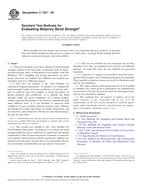Potrebujeme váš súhlas na využitie jednotlivých dát, aby sa vám okrem iného mohli ukazovať informácie týkajúce sa vašich záujmov. Súhlas udelíte kliknutím na tlačidlo „OK“.
ASTM C1357-09
Standard Test Methods for Evaluating Masonry Bond Strength (Withdrawn 2016)
Automaticky preložený názov:
Štandardné skúšobné metódy pre hodnotenie Murivo Súdržnosť
NORMA vydaná dňa 1.6.2009
Informácie o norme:
Označenie normy: ASTM C1357-09
Poznámka: NEPLATNÁ
Dátum vydania normy: 1.6.2009
Kód tovaru: NS-10831
Počet strán: 9
Približná hmotnosť: 27 g (0.06 libier)
Krajina: Americká technická norma
Kategória: Technické normy ASTM
Kategórie - podobné normy:
Anotácia textu normy ASTM C1357-09 :
Keywords:
flexural bond strength, masonry, Bond strength--masonry/mortar, Masonry strength, Masonry units, ICS Number Code 91.080.30 (Masonry)
Doplňujúce informácie
| Significance and Use | ||||||||||||||||
|
This test method is intended for use in comparing the bond strengths (under the given conditions) of masonry mortars, as determined in accordance with Test Method C 1072. This test method could be used, for example, to check one aspect of the quality of mortar products after production, or to indicate the bond potential of a mortar product without requiring the product to be tested in combination with many different units. This test method uses controlled conditions of fabrication and curing that are not intended to represent field conditions. This test method uses standard concrete masonry units. Mortars are batched by weight equivalents of volume proportions and are mixed to a prescribed flow. Prisms are constructed using a jig and are bag-cured. Flexural bond strength determined by this test method shall not be interpreted as the flexural bond strength of a wall (because standard units are not used for wall construction), nor shall it be interpreted as an indication of extent of bond for purposes of water permeability evaluation. |
||||||||||||||||
| 1. Scope | ||||||||||||||||
|
1.1 These test methods cover the evaluation of flexural bond strength, normal to the bed joints, of masonry built of manufactured masonry units, as determined in accordance with Test Method C 1072. Sampling and testing procedures are referenced, and terms are defined. Two different test methods are specified, each for a different purpose: 1.1.1 The first test method is the “Test Method for Laboratory-Prepared Specimens.” Its purpose is to compare the bond strengths (under the given conditions) of masonry mortars. It could be used, for example, to check the quality of mortar products after production, or to indicate the bond strength (under the given conditions) of a mortar product without requiring the product to be tested in combination with many different units. It is not intended to represent field conditions. It uses standard concrete masonry units. Mortars are batched by weight equivalents of volume proportions and are mixed to a prescribed flow. Prisms are constructed using a jig and are bag-cured. Note 1—Standard fired clay masonry units are under development but are not now available. When their development is complete, they will be incorporated into these test methods. 1.1.2 The second test method is the “Test Method for Field-Prepared Specimens.” Its purpose is to evaluate the bond strength (under the given conditions) of a particular unit-mortar combination, either for preconstruction evaluation of materials or for quality control purposes during construction. Mortars are batched conventionally, and the flow is not prescribed. Prisms are constructed conventionally (no jig) and are bag-cured. 1.1.3 The two test methods are not consistent, nor are they intended to be. They are intended to be used for two different purposes. To make this clear, the two methods are presented separately. 1.1.4 Appendix X1 suggests two possible criteria for assessing the bond strength values obtained using these test methods. These possible evaluation criteria are given for illustration only and are not mandatory. 1.2 The values stated in inch-pound units are to be regarded as standard. The values given in parentheses are mathematical conversions to SI units that are provided for information only and are not considered standard. 1.3 This standard does not purport to address all of the safety concerns, if any, associated with its use. It is the responsibility of the user of this standard to establish appropriate safety and health practices and determine the applicability of regulatory limitations prior to use. |
||||||||||||||||
| 2. Referenced Documents | ||||||||||||||||
|
Odporúčame:
EviZak - všetky zákony vrátane ich evidencie na jednom mieste
Poskytovanie aktuálnych informácií o legislatívnych predpisoch vyhlásených v Zbierke zákonov od roku 1945.
Aktualizácia 2x v mesiaci !
Chcete vedieť viac informácii ? Pozrite sa na túto stránku.




 Cookies
Cookies
